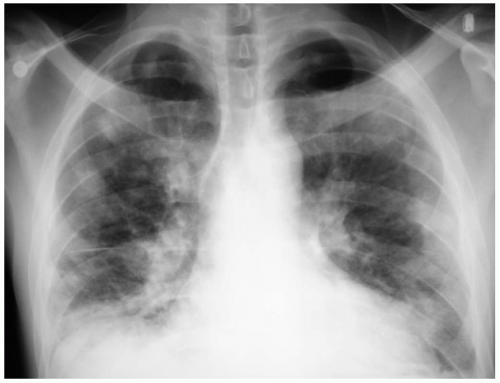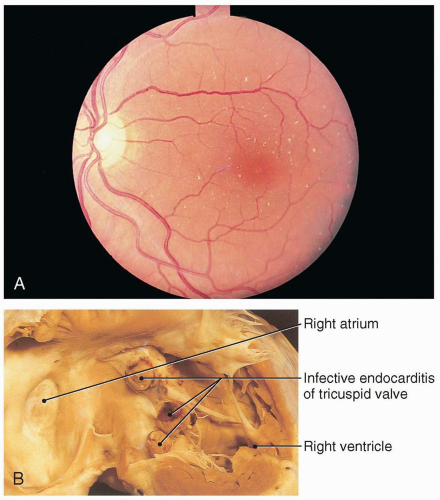Complications of Drug Abuse
32-1 Substance Abuse: Infectious Disease Complications
Anthony Morocco
A variety of infections occur in injection drug users. They are caused by diverse organisms that include bacteria, viruses, and fungi. Injection drug and alcohol abusers are also more likely to develop community-acquired and aspiration pneumonia, as well as tuberculosis.
Soft-Tissue Infections
Soft-tissue infections are usually caused by skin flora, most commonly Streptococcus and Staphylococcus species. Anaerobic bacteria are also commonly involved and may be introduced if the user licks the needle before injection. (This activity is thought by some drug users to “clean” a previously used needle.) An unusual infection is wound botulism, which is related to the production of toxin by Clostridium botulinum. This condition has recently been associated with the use of black tar heroin.1
Endocarditis
Endocarditis occurs in injection drug users after progressive valvular damage and fibrin deposition, which allow microorganism adherence. The estimated incidence is 2 cases per 1,000 addicts per year, with the right and left sides of the heart equally affected. The most common pathogen is Staphylococcus aureus, followed by Streptococcus species. Echogenic vegetations may be visualized on echocardiography even after bacterial eradication, and 20% of patients require surgical intervention. Septic emboli may affect the lungs or any end organ.1
Viral Infections
Injection drug users may develop viral illnesses such as hepatitis B and C and human immunodeficiency virus (HIV) infection. Acquired immunodeficiency syndrome (AIDS) also results in increased susceptibility to a multitude of opportunistic infections. Bacterial pneumonia is four times more common among drug users who are HIV-positive. Tuberculosis is also more common in HIV patients, and it commonly results in extrapulmonary disease in this population. Other HIV-related infections are caused by cytomegalovirus (CMV), toxoplasmosis, Mycobacterium avium-intracellulare, and Cryptococcus species.
Other Infections
Other potential infections caused by injection drug use include osteomyelitis, septic arthritis, malaria, epidural abscess, and brain abscess.1 Vertebral osteomyelitis occurs after hematogenous seeding of the bone or facet joints. The infection may spread locally to cause epidural abscess and myelitis.2 Septic arthritis and costochondritis occur after hematogenous spread of bacterial and occasionally fungal pathogens. Injection drug users may develop unusual locations for these infections, such as sternoclavicular, acromioclavicular, and sacroiliac joints.2
A number of ophthalmic infections occur in injection drug users, including endophthalmitis due to Candida, Aspergillus, Bacillus, and Staphylococcus species.
REFERENCES
1. Stein MD. Medical consequences of substance abuse. Psychiatr Clin North Am 1999;22:351-370.
2. Gotway MB, Marder SR, Hanks DK, et al. Thoracic complications of illicit drug use: an organ system approach. Radiographics 2002;22(Spec No):S119-S135.
32-2 Substance Abuse: Cardiovascular Complications
Anthony Morocco
Injection Drug Use
Use of illicit substances may cause a variety of cardiovascular complications. Injection drug use may result in bacterial endocarditis, leading to permanent valve damage and congestive heart failure, as well as disseminated infection. Talc and other inert substances may be found as adulterants in commonly injected drugs such as cocaine, heroin, and methamphetamine. Pills such as methylphenidate and oxycodone also contain inert ingredients such as talc and cellulose, which are introduced into the vasculature when the pills are crushed, mixed with water, and injected. Deposition of talc or cotton in the pulmonary vasculature may occlude vessels and result in granuloma formation and pulmonary hypertension. Neovascularization of the retina may also occur due to talc. Cotton fibers may be inadvertently injected intravenously when cotton (e.g., cigarette filters) is used to filter the drug solution before use.1,2 Several vascular complications may result from intravenous drug use, including pseudoaneurysm formation, necrotizing angiitis, needle embolus, and mycotic aneurysm.1 Subclavian and carotid pseudoaneurysms may result from injection into the supraclavicular fossa (colloquially known as a “pocket shot”).2
Cocaine
Cocaine use is associated with serious cardiotoxicity, including myocardial infarction, arrhythmias, and sudden death. Mechanisms may include coronary vasospasm, increased myocardial oxygen demand, premature atherosclerosis, and enhanced platelet aggregation. Cocaine exerts a sodium-channel blocking effect similar to the class I antiarrhythmic drugs.1 Cocaine may also cause cerebral vasospasm, hemorrhagic or ischemic stroke, cerebral vasculitis, or mesenteric arterial vasoconstriction and ischemia. Cocaine is associated with the development and propagation of aortic dissection due to vasoconstriction, hypertension, and tachycardia.1,2











